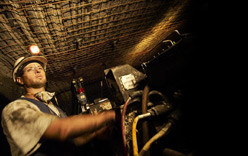CUTTING METHODS
Most aspects of alternative cutting methods and cutting procedures have been referred to in the Longwall section of the Fundamentals of Coal Mining module of this web site and little can be added here. The basic cutting methods are Bi-di and Uni-di. "Half Web" methods have been introduced to provide several benefits, mainly in productivity, but at a cost of being more complex (not a cost once crews are fully trained). Some Half Web systems can provide similar benefits to Pre-cutting, also described in the Longwall section of the Fundamentals of Coal Mining module, but with additional benefits.
Depending on the equipment used and the mine's coal haulage capacity, Bi-di mining is often more productive than Uni-di, especially with longer faces, and can handle poor strata conditions better. Uni-di however is a simpler system to operate, enables operators to keep away from high dust concentrations, can allow the loading onto the coal haulage system to be made more even and can at times equal or even exceed Bi-di production. The Half Web systems can be used to gain the benefits of both Bi and Uni-di if operated correctly and in the right conditions.
For a good detailed description of the alternative processes, reference must again be made to Mitchell(1). To include a description here would only be plagiarism, in effect, and will not be attempted. It is unfortunate that this work is not at present available on the Internet, but a link is provided in the references section to a copy of Mitchell's work. Good descriptions of the alternative cutting processes are also available in the paper by Niehaus, et al, on the link immediately below.
http://www.bgmr.rwth-aachen.de/downloads/hpmpartikel.pdf - paper by K Nienhaus, A K Bayer & H Haut, Aachen University of Technology, Germany, entitled "Higher Productivity - A Question of Shearer Loader Cutting Sequences"
When deciding a cutting method it is important that all aspects of the choice are considered – a Queensland Mines Inspectorate report (see link below) discusses where an effect of Uni-di cutting was to cause "fixed" cables to move in the cable tray resulting in exposed loops of cable at mid-face. This is a safety alert which demonstrates possibly unforseen complications of a cutting process chosen.

